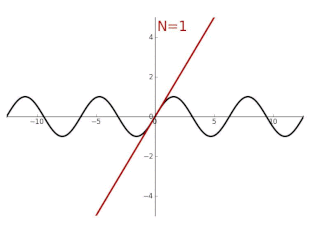Math for Non-Geeks/ Sine and cosine
{{#invoke:Math for Non-Geeks/Seite|oben}}
In this chapter we introduce the two trigonometric functions sine and cosine. They are the most important trigonometric functions and are used in geometry for triangle calculations and trigonometry. Waves such as electromagnetic waves and harmonic oscillations can be described by sine and cosine functions, so they are also omnipresent in physics.
Definition via unit circle
There are several ways to define the sine and cosine. The visually most accessible one is that on the unit circle. Here, a point is considered that is located on a circle around the origin with radius . The axis includes the angle with the distance from the origin to :

The angle uniquely determines where the point is located. Thus the -coordinate and the -coordinate can be described by a function depending on . We call these functions and the sine function and cosine function respectively:

In the following we take as the angle and write instead of and instead of . This results in the following definition:
Math for Non-Geeks: Template:Definition
Graph of the sine and cosine function
The following animation shows how the graphs of the sine and cosine functions are constructed step by step:

This gives the following graph for the sine function:

For the cosine function we get:

Definition via exponential function
Representation by the complex exponential function
The sine and cosine function can also be defined as the sum of certain complex exponential functions. With this representation, properties of the sine and cosine can be demonstrated in a particularly elegant way.
Math for Non-Geeks: Template:Definition
These functions are well-defined: For every real number the complex number is the complex conjugate of . Thus is a real number and there is . In an analogous way, one can show that .
Deriving the exponential definition
One can show that is the point on the unit circle whose position vector with the axis encloses the angle :

The real part of the complex number is , and the imaginary part is . There is hence . At we consider the angle . The point is mirrored on the real axis on the other side:

Thus the real part of is the same as for , i.e. . However, the imaginary part is multiplied by the number and thus equal to . We get . So we have:
By adding both equations we get:
And by subtracting the two equations we get:
Thus we have derived the two definitions and . This derivation is illustrated again in the following figure:

Series expansion of sine and cosine
Definition as a series

.
Another mathematically precise definition that does not require geometrical notions is the so-called series representation, in which the sine and cosine are defined as a series. The series representation is less visual than the definition over the unit circle, but with it some properties of the sine and cosine can be proved more easily. It can also be used to extend the sine and cosine to complex numbers.
Math for Non-Geeks: Template:Definition
Well-definedness
We have to prove that our series representation of the sine and cosine function is well-defined. That is, we have to show that for all the series and converge to a real number.
Math for Non-Geeks: Template:Satz
Equivalence of exponential and series definition
We have learned several definitions of the sine and cosine function. We have already established a connection between the exponential representation and the definition on the unit circle. Now we need to show that the exponential and series definitions are equivalent to each other.
Math for Non-Geeks: Template:Satz
{{#invoke:Math for Non-Geeks/Seite|unten
|weblinks=
|quellen=
- German page „Sinus und Kosinus“. In: Wikipedia, Die freie Enzyklopädie. Version of: March 17 2017, 07:54 UTC. URL: https://de.wikipedia.org/w/index.php?title=Sinus_und_Kosinus&oldid=163536340 (Accessed on Mar 17 2017, 16:03 UTC)
}}